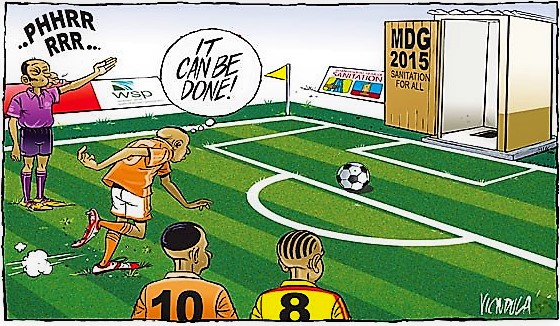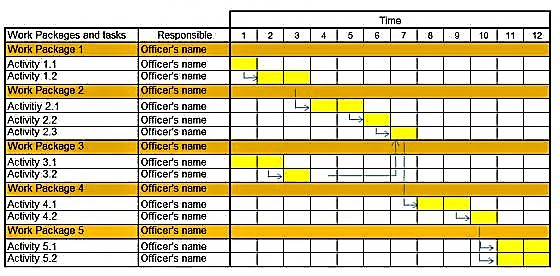Executive Summary
All those who have been involved in a project will agree that making a project succeed is not simple. The difficulties are manifold: delays, excessive budget over-runs, inadequate results, dissatisfied end-beneficiaries, high stress among the project team and other undesirable outcomes. Therefore, the purpose of these project management guidelines is to help you to organise, plan and control your projects to make sure you do not encounter these difficulties. Projects are characterised by four features: a group of people, a goal, limited time and money and a certain level of uncertainty regarding whether the goals will be achieved. Project managers are involved with all of these aspects, which makes supervising and directing a project anything but an easy task. Following these lines will help you to maximise the potential for your projects to succeed by helping you address each element of your project at the right time and to the right level of detail for the size and complexity of your project.
Introduction
In the last decades, projects became increasingly common in the water and sanitation sector. Project-based working methods have found their way into non-profit organisations. “The rules of the game for projects in non-profit organisations differ from those in commercial organisations, because there are political factors that play a particularly important role in the public sector. This makes it even more difficult for projects to succeed, compared to projects in which commercial aspects play a part. Project leaders should be aware of this and be able to play the game of politics” (BAARS 2006).
Definition of Project
A project is a unique venture to produce a set of outputs within clearly specified time, cost and quality constraints. Projects differ from standard business operational activities as they (adapted from METHOD123 2003):
- Are distinctive in nature, not involving a repetitive process.
- Have a define time-plan, with a specified start and end dates to meet the beneficiaries or funding agency’s requirements.
- Have an allocated budget, which should be spent to produce the deliverables.
- Have limited resources, such as labour, material and equipment.
- Involve a risk, as there is a level of uncertainty whether the objectives will be attained.
To Be Successful a Project Must
(Adapted from BERR 2007)
Deliver the outcomes and benefits required by the organisation, its delivery partners and other stakeholder organisations.
- Create and implement deliverables that meet agreed requirements.
Meet time targets.
- Stay within financial budgets.
- Involve all the right people.
- Make best use of resources in the organisation and elsewhere.
- Take account of changes in the way the organisation operates.
- Manage any risks that could jeopardise success.
- Take into account the needs of staff and other stakeholders who will be impacted by the changes brought about by the project.

Definition of Project Management
Project management is a carefully planned effort to accomplish a specific objective, using knowledge, skills, tools, and techniques to plan and implement activities to meet or exceed stakeholder needs and expectations from a project.
The final aim of managing projects in the water and sanitation sector should be to “implement activities identified and planned for in the previous phases in an effective, cost-efficient and high quality way” (MORIARTY et al 2007).
Components of Project Management
(Adapted from BAARS 2006)

Improper project management is just one of the factors that can cause a major delay in achieving the project goals. Source: WSP (2002)
- Team: A project team is comprised of a group of people who will realise the project result. The group is often comprised of people who have various backgrounds, each of whom contributes knowledge and skills.
- Goal: A product result (or goal) is desired. After a project has been completed, something has been realised. A new treatment system has been implemented, a training course has been carried out or an assessment has been done. In many projects, it is necessary to adapt the goal as the project proceeds.
- Limited resources: The amount of time and money that is available for completing a project is always limited. No project is completely free of time pressure.
- Uncertainty (risk): One characteristic feature of projects is that their success is never guaranteed beforehand. Even if the desired goal is already being reached, it is uncertain whether it will be achieved within the available budget or within the proposed time. It is not unusual for a project to take three times as long and to cost twice as much as originally estimated. It is also not unusual for only thirty per cent of the original project team members to be working on the project upon its completion.
Although project managers must attend to many matters, they actually direct projects along only five parameters:
- Time
- Money
- Quality
- People (organisation)
- Information
These five parameters, which are often known as the “control factors”, are described further below. The control factors appear in project plans, progress monitoring and project reporting.
Managing Time
(Adapted from BAARS 2006)
The time factor manifests itself in a project in the form of deadlines for tasks and the amount of time that these tasks may take. Managing time involves ensuring that tasks are completed on time.
Time in project plans:
- Determine which activities should take place in which phase.
- Estimate how long each activity will take.
- Determine the order in which activities should be completed.
- Allocate people and materials.
- Allocate activities over time.
- Determine the (most important) deadlines.
Time in progress monitoring:
- Monitor progress.
- Monitor deadlines.
- Adjust schedules.
Time in project reporting:
- Report on the actual timeline.
- Analyse and explain why some tasks proceeded much more quickly or much more slowly than expected.
Time schedules are based on a work-breakdown structure (WBS). A WBS is a decomposition of the tasks that must be completed in order to achieve the project result, such as Work Packages or Activity Packages. Developing a time schedule requires knowing the amount of time that is needed for each task, who will complete each task and when. One frequently used tool for planning time is the bar chart or Gantt chart.

The Gantt chart is a specialised bar chart used to provide a graphical overview and schedule of all tasks to indicate the work elements and dependencies of project. This is a chart with rectangular bars. The length of each bar is proportional to the time value necessary for each task on the work breakdown structure. The final product illustrates the schedule of a project (MANAGING PROJECT RISKS 2009).
Managing Money
(Adapted from BAARS 2006)
The money factor manifests itself in the project budget. The management of money within a project involves ensuring that the costs remain within the budget. Given that the majority of the costs in most projects are comprised of labour costs, the factors of money and time (the number of labour hours) are closely intertwined.
Money in project plans:
- Determine the fees of the team members.
- Estimate the hours for the team members.
- Assign budgets to team members for specific tasks.
- Determine costs for material and tools.
Money in progress monitoring:
- Monitor cash flow.
- Negotiate with suppliers.
- Determine whether the original cost estimates are still accurate.
- Adjust budgets.
- Negotiate with customer and/or client concerning budget adjustments.
Money in project reporting:
- Compile financial reports and statements.
- Analyse definitive financial report.
Managing Quality
(Adapted from BAARS 2006)
The project result must fulfil a number of quality requirements. This also applies to the various intermediate products of the project. When managing a project, it is particularly important for quality requirements to be determined, agreed upon and recorded in writing during the definition phase. These requirements should never remain implicit. A clear list of requirements can be checked at the end of the implementation phase. This can allow the project team to prove that they have carried out the project according to specifications. Additional quality requirements may be specified for various tasks within the project. For example, a particular task can be carried out only by certified personnel.
Quality in project plans:
- Establish the desired quality of the project result and the intermediate products.
- Establish the desired quality of the carrying out of the various activities in the project.
Quality in progress monitoring:
- Test the (intermediate) results.
- Address any quality problems.
- Quality in the project reporting:
- Confirm that the desired quality has been attained.
- Address any complaints (particularly in the follow-up phase).
Managing People
(Adapted from BAARS 2006)
Within a project, the team must be managed. In the narrowest sense, team management involves determining who will do what from the list of activities. In broader terms, it also involves all of the soft skills (e.g. motivational techniques, communication skills, leadership styles) that are needed to achieve a goal with a group of people.
Organisation in project plans:
- Assemble the team.
- Assign authority.
- Assign tasks to team members.
- Make agreements concerning the availability of people with other (project) managers and higher management.
Organisation in progress monitoring:
- Direct the team.
- Monitor human aspects (soft skills).
- Mediate between the parties who are involved in the project.
Managing Information
(Adapted from BAARS 2006)
The information factor concerns how, by whom and on which basis decisions can be taken, as well as which tools (e.g. project website, issue tracker, e-mail notification, joint agenda) will be used for communication. These and other informational issues must be answered before a project can be started. Organisations that regularly work with projects have a number of tools (e.g. Word templates) on hand for handling information within a project.
Information in project plans:
- Which information must be provided to whom and in which form?
- Which information will be recorded, distributed and archived?
- Which information tools will be used?
Information in progress monitoring:
- Arrange for periodic consultation.
- Ensure that the right information is provided to the right person.
- Determine whether agreements have been met.
Information in project reporting:
- Write the project report.
Any task that requires some preparation to achieve a successful outcome will probably be done better by using a few project management methods somewhere in the process. Project management methods can help in the planning and managing of all sorts of tasks, especially complex activities.
Project management techniques and project planning tools are useful for any tasks in which different outcomes are possible ― where risks of problems and failures exist ― and so require planning and assessing options, and organising activities and resources to deliver a successful result.
Project Management Handbook, Version 1.1 – July 2006
This project management tutorial is intended for anyone who is involved in or will be involved in projects that take place within or are conducted in association with DANS (Data Archiving and Networked Services). The text, however, has been prepared in such a way that it can be used by other organisations, particularly those in the non-profit sector, that use project-based working methods.
BAARS, W. (2006): Project Management Handbook, Version 1.1 – July 2006. URL [Accessed: 19.06.2019]Guidelines for Managing Projects
The purpose of these project management guidelines is to help you to organise, plan and control your projects. They are designed to help you to maximise the potential for your projects to succeed by helping you address each element of your project at the right time and to the right level of detail for the size and complexity of your project.
BERR- DEPARTMENT FOR BUSINESS, ENTERPRISE AND REGULATORY REFORM (2007): Guidelines for Managing Projects. London: BERR URL [Accessed: 23.06.2019]Importance of Gantt Charts in Project Management
Project Management Guidebook
This eBook helps you to manage projects more successfully by describing each of the steps in the project lifecycle.
METHOD123 (2003): Project Management Guidebook. URL [Accessed: 23.06.2019]The EMPOWERS Approach to Water Governance: Guidelines, Methods and Tools
The guideline provides information necessary to understand the EMPOWERS approach of water governance and explains in details how to use the approach for planning and implementation of water management and related issues.
MORIARTY, P. BATCHELOR, C. ABD-ALHADI, F. LABAN, P. FAHMY, H. (2007a): INWRDAM The EMPOWERS Approach to Water Governance: Guidelines, Methods and Tools. pdf presentation. Amman, Jordan: Inter-Islamic Network on Water Resources Development and Management (INWRDAM) URL [Accessed: 18.03.2010]Advantages and Disadvantages of Project Management
WSP 2002 Cartoon Calendar
WSP 2009 Cartoon Calendar
Guidelines for Managing Projects
The purpose of these project management guidelines is to help you to organise, plan and control your projects. They are designed to help you to maximise the potential for your projects to succeed by helping you address each element of your project at the right time and to the right level of detail for the size and complexity of your project.
BERR- DEPARTMENT FOR BUSINESS, ENTERPRISE AND REGULATORY REFORM (2007): Guidelines for Managing Projects. London: BERR URL [Accessed: 23.06.2019]Project Management Guidebook
This eBook helps you to manage projects more successfully by describing each of the steps in the project lifecycle.
METHOD123 (2003): Project Management Guidebook. URL [Accessed: 23.06.2019]Human Resource Management in a Project
This paper gives a description of the process required to coordinate the human resources in a project.
MISHRA, S. (2007): Human Resource Management in a Project. In: PM World Today: Volume 9Project Management Fact Sheet: Developing a Gantt Chart, Version: 1.2.
ThisFactsheet will help you to develop your own Gantt Chart for your project.
TASMANIAN GOVERNMENT PROJECT MANAGEMENT FRAMEWORK (2008): Project Management Fact Sheet: Developing a Gantt Chart, Version: 1.2. . URL [Accessed: 23.06.2019]Project Management Handbook, Version 1.1 – July 2006
This project management tutorial is intended for anyone who is involved in or will be involved in projects that take place within or are conducted in association with DANS (Data Archiving and Networked Services). The text, however, has been prepared in such a way that it can be used by other organisations, particularly those in the non-profit sector, that use project-based working methods.
BAARS, W. (2006): Project Management Handbook, Version 1.1 – July 2006. URL [Accessed: 19.06.2019]10 Keys for Local and National Action
Ten key points that are prerequisite for successful municipal wastewater management. They cover policy issues, management approaches, technology selection and financing mechanisms.
UNEP ; WHO ; UN-HABITAT ; WSSCC (2003): 10 Keys for Local and National Action . The Hague: United Nations Environment Programme Global Programme of Action (UNEP/GPA), Coordination Office URL [Accessed: 30.06.2019]Project Management Learning
Project Management Learning is an excellent reference for questions and answers on project management. The website, with its exhaustive articles, highlights the importance of project management in our current world, where any endeavour can be seen and treated as a project.
Brainstorming - Generating Many Radical, Creative Ideas
A very useful site that contains an extensive description of brainstorming, and includes also information on other techniques. Furthermore, it also describes alterations of the classical brainstorming.
WASH Sustainability Index Tool
The WASH Sustainability Index Tool, developed for the USAID-Rotary International H2O Collaboration, is a tool to assess sustainability of WASH programs. The tool considers the sustainability of institutional, management, financial, technical and environmental factors.


